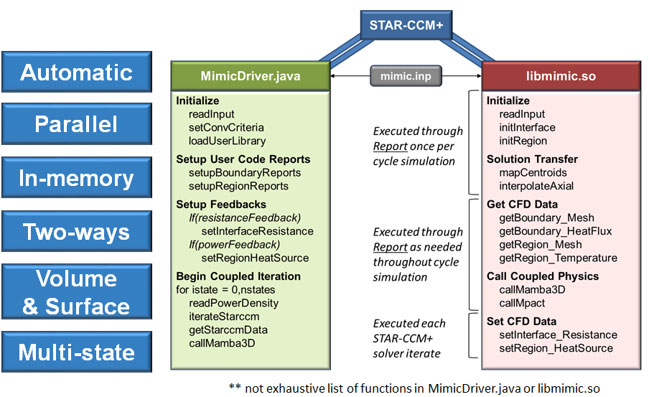CFD-based Multi-Physics Interface MIMIC
Project Description
The multi-physics coupling framework MIMIC (Michigan Interface for Multi-state In-memory Coupling) was developed to couple the commercial CFD code STAR-CCM+ with other physics. The primary focus for the development are Nuclear Reactor Applications, however the framework can be used to couple CFD with any other physics.

MIMIC is a computational tool that facilitates in-memory coupling with STAR-CCM+ by leveraging the STAR-CCM+ Java API and so-called user code functionality. It is specifically designed for nuclear fuel rod array analysis, but may be used for other applications as well. Currently, MIMIC supports in-memory two-way coupling with the direct-solution neutronics suite MPACT and the CRUD deposition solvers MAMBA-3D and MAMBA-1D. A file-based, one-way coupling with the fuel performance code BISON is also supported.
MIMIC coordinates the coupled cycle simulation, where multiple STAR-CCM+ states may be converged throughout a reactor cycle simulation. MIMIC adopts the operator-split coupling approach, which treats each unique physics code independently and couples them through their boundary conditions.
Moreover, MIMIC gives the user control over the temporal coupling as well as coupled physics convergence through the use of fixed-point iteration. User input parameters give control over which physics are coupled, and whether their coupling is one- or two-way; this allows convenient sensitivity studies and analyses. In addition, coupled physics software can be run simultaneously with MIMIC, or instead, pre-generated physics values can be read in through file-based coupling.
MIMIC is capable of surface- and volume-based solution transfer between non-conformal meshes. Moreover, for coupling with MPACT, both STAR-CCM+ and MPACT may be uniquely spatially decomposed for efficient parallel execution. MIMIC handles all of the processor communication and solution transfer.
Examples of applications include:
- CRUD deposition on PWR fuel rods
- Hydride precipitation in nuclear fuel cladding
References
- Petrov, V., Kendrick, B., Walter, D., Manera, A., Secker, J., “Prediction of CRUD deposition on PWR fuel using a state-of-the-art CFD-based multi-physics computational tool”, Nuclear Energy and Design (CFD4NRS-5 special issue), 299, pp. 95 – 104 (2016).
- Walter, D., Manera, A., “CRUD and Boron Layer 2-D Modeling Requirements using MOC Neutron Transport”, Annals of Nuclear Energy, 87 (2), pp. 388 – 399 (2016).
- Walter, D., Petrov, V., Kendrick, B., Manera, A., Collins, B., Downar, T., “Proof-of-principle of High-Fidelity Coupled CRUD Deposition and Cycle Depletion Simulation”, Annals of Nuclear Energy, 85, pp. 1152-1166 (2015).
- Walter, D., Petrov, V., Adamowicz N., Manera, A., “MIMIC: Michigan Interface for Multi-state In-memory Coupling with STAR-CCM+ for Nuclear Applications”, Proc. of M&C 2017 – International Conference on Mathematics; Computational Methods Applied to Nuclear Science Engineering, 2017.
- Aly, V. Petrov, M. Abramova, A. Manera, K., Ivanov, Evaluation of the mixing vaneson the hydrogen diffusion and hydride formation in the fuel cladding, accepted for publication in Proc. of the 26th Int. Conf. on Nuclear Engineering, ICONE-26.
- A. Aly, V. Petrov, A. Casagranda, M. Avramova, A. Manera, K. Ivanov, “The effect of the resolution of the TH codes on prediction of hydrogen distribution and hydride formation in rod bundles”, PHYSOR 2018 conference (2018).